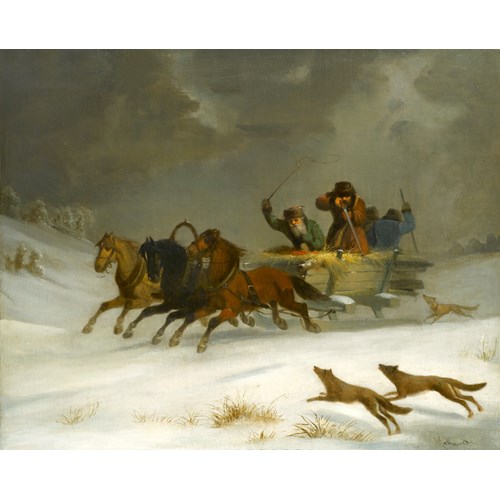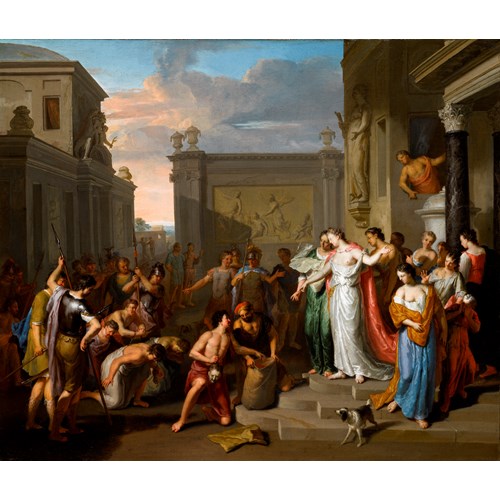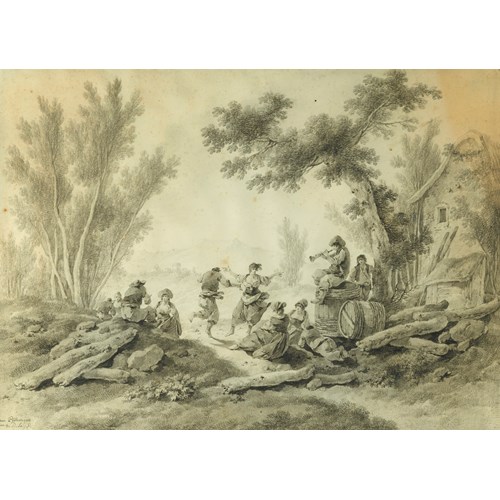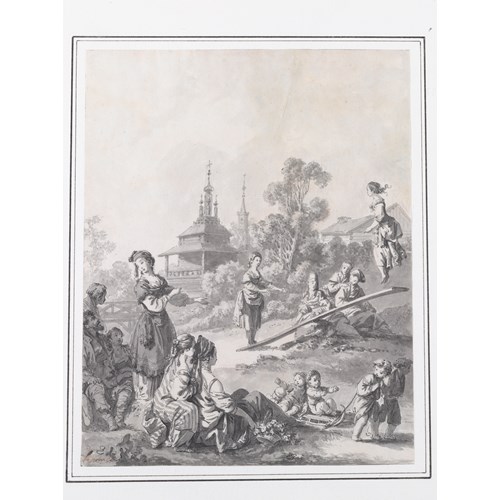Marketplace
The Hay Market, St. Petersburg, 1820
Alexander Osipovich Orlovsky
The Hay Market, St. Petersburg, 1820
Date 1820
Epoque 1750-1850, 19th century
Origine Poland, Russia
Medium Oil on board
Dimension 42 x 54 cm (16¹/₂ x 21¹/₄ inches)
This lively genre painting depicts the Hay Market at St. Petersburg or 'Sennaya Ploshchad', 'seno' being the Russian word for hay. The market place dates back to 1737 and was considered to be the ‘belly’ of St. Petersburg. It was the trading hub for peasants, farmers and merchants exchanging and selling firewood, cattle, crops and hay. The baker on the right is about to set up a trestle-table and uncover his freshly baked loaves, while the butcher has a sledge of slaughtered pigs, one of which is being pulled apart by an eager customer. Horses, peoples' legs, sledge-tracks and animals crowd the foreground, and the scene is equally full as your eye wanders upward through the dense mass of faces and figures, it is only the militaristic horseman with his plumed fur hat and lance that cuts through the icy middle-distance horizon.
During this time, Alexander Osipovich Orlovsky frequently sketched the streets of St. Petersburg, many of his drawings being strong in social commentary such as Peasant on a Wagon (1812), Train of Peasant Carts (1810), or Destitute Peasants by a Carriage (1815) quite sometime ahead of the French Realists. In some ways, similarities can, instead, be drawn with the English painter and printmaker William Hogarth, who often made a social critique within his work. Equally the energy of the market and its variety of characters, their interplay within the setting and the way the viewer is immersed into the scene as if taking part are also reminiscent of the work of Pieter Brueghel the Elder and works such as The Wedding Feast, (c.1567-68). Like Hogarth's pictures Orlovsky's were often engraved, and The Hay Market, St. Petersburg, 1820 is a popular engraving.
At the time this work was painted, the Imperial capital of St. Petersburg was under the rule of Tsar Alexander I. Alexander’s reign marked the heyday of Russian architecture with its linear classical designs. In this period the Admiralty was remodelled, the Stock Exchange built on Vasilevsky Island and work on St. Issac’s Cathedral was begun. Alexander I enacted a series of reforms creating a new bureaucratical government structure and St. Petersburg became a very regimented city with heavy policing. In this painting Orlovsky, once again, makes a nod to the social climate of his time, as behind bustling characters and jovial faces we see one of Alexander’s horse-backed guards maintaining a hawk’s eye on proceedings.
The area surrounding the Hay Market later became home to Dostoevsky. Renowned for unsavoury characters, the area provided him with ample inspiration for the setting and characters of Crime and Punishment in 1866. Dostoevsky himself spent a couple of days in prison for violating censorship rules in the journal Grazhdanin, in a building which is now called the Senior Officers’ Barracks and which is situated just off the main square. The majestic Church of the Assumption (built between 1753 and 1765) that once dominated the square’s skyline and which later became a focal point for anti-Soviet demonstrations, it was demolished in 1961 and replaced by a new metro station.
Orlovsky was a talented battle scene painter, portrait painter and caricaturist whose range of medium included watercolours, oils, engravings and pastels. Born in Warsaw in 1777 his father ran an inn in the small provincial town of Sedlitz. It was here that his talent was discovered by Princess Isabella Czartoryski, who sent him to the Warsaw Art School in 1793 where he trained under J.P. Norblin de la Gourdaine. He also studied under the Polish court painter Marcello Bacciarelli, the engraver Bartolomeo Follin and the Polish miniaturist Wincenty Fryderyck Lesseur (1745-1813). Orlovsky travelled extensively and was a volunteer in the partisan group led by Thadeusz Kosciuszko in the Polish liberation movement and uprising of 1794. His early work shows an interest in the national liberation movement, and following the defeat of the movement he worked with a group of travelling actors for a brief period, though few works from this period survive. In 1799 Orlovsky served Prince Józef Poniatowski (1763-1813) as a caricaturist and he subsequently travelled around Lithuania.
He moved to Russia in 1802 where he settled in St. Petersburg and was a court artist for the Grand Duke Konstantin Pavlovich, for whom he executed drawings of uniforms and military parades. During his period in St. Petersburg he created numerous genre scenes and also society portraits. Most of his paintings from this time, however, were scenes of army life and battles, as well as romantic subjects featuring brigands and shipwrecks. In 1809 he received the title of Academician of Battle Painting for his picture Cossack Bivouac. During the war of 1812 against Napoleon, Orlovsky produced several drawings of leading military figures. In 1816 he became one of the first artists to produce lithographs in Russia. He produced forty lithographs for Gaspar Drouville’s book Puteshestviye v. Persiyn (1819), and in 1826 two large volumes of Russian scenes; Russkiye al’bomy and Kollektsiya Orlovskogo (Orlovsky’s Collection). After 1819 he worked as a graphic artist for the Topographic Department of the Army Headquarters.
During this time, Alexander Osipovich Orlovsky frequently sketched the streets of St. Petersburg, many of his drawings being strong in social commentary such as Peasant on a Wagon (1812), Train of Peasant Carts (1810), or Destitute Peasants by a Carriage (1815) quite sometime ahead of the French Realists. In some ways, similarities can, instead, be drawn with the English painter and printmaker William Hogarth, who often made a social critique within his work. Equally the energy of the market and its variety of characters, their interplay within the setting and the way the viewer is immersed into the scene as if taking part are also reminiscent of the work of Pieter Brueghel the Elder and works such as The Wedding Feast, (c.1567-68). Like Hogarth's pictures Orlovsky's were often engraved, and The Hay Market, St. Petersburg, 1820 is a popular engraving.
At the time this work was painted, the Imperial capital of St. Petersburg was under the rule of Tsar Alexander I. Alexander’s reign marked the heyday of Russian architecture with its linear classical designs. In this period the Admiralty was remodelled, the Stock Exchange built on Vasilevsky Island and work on St. Issac’s Cathedral was begun. Alexander I enacted a series of reforms creating a new bureaucratical government structure and St. Petersburg became a very regimented city with heavy policing. In this painting Orlovsky, once again, makes a nod to the social climate of his time, as behind bustling characters and jovial faces we see one of Alexander’s horse-backed guards maintaining a hawk’s eye on proceedings.
The area surrounding the Hay Market later became home to Dostoevsky. Renowned for unsavoury characters, the area provided him with ample inspiration for the setting and characters of Crime and Punishment in 1866. Dostoevsky himself spent a couple of days in prison for violating censorship rules in the journal Grazhdanin, in a building which is now called the Senior Officers’ Barracks and which is situated just off the main square. The majestic Church of the Assumption (built between 1753 and 1765) that once dominated the square’s skyline and which later became a focal point for anti-Soviet demonstrations, it was demolished in 1961 and replaced by a new metro station.
Orlovsky was a talented battle scene painter, portrait painter and caricaturist whose range of medium included watercolours, oils, engravings and pastels. Born in Warsaw in 1777 his father ran an inn in the small provincial town of Sedlitz. It was here that his talent was discovered by Princess Isabella Czartoryski, who sent him to the Warsaw Art School in 1793 where he trained under J.P. Norblin de la Gourdaine. He also studied under the Polish court painter Marcello Bacciarelli, the engraver Bartolomeo Follin and the Polish miniaturist Wincenty Fryderyck Lesseur (1745-1813). Orlovsky travelled extensively and was a volunteer in the partisan group led by Thadeusz Kosciuszko in the Polish liberation movement and uprising of 1794. His early work shows an interest in the national liberation movement, and following the defeat of the movement he worked with a group of travelling actors for a brief period, though few works from this period survive. In 1799 Orlovsky served Prince Józef Poniatowski (1763-1813) as a caricaturist and he subsequently travelled around Lithuania.
He moved to Russia in 1802 where he settled in St. Petersburg and was a court artist for the Grand Duke Konstantin Pavlovich, for whom he executed drawings of uniforms and military parades. During his period in St. Petersburg he created numerous genre scenes and also society portraits. Most of his paintings from this time, however, were scenes of army life and battles, as well as romantic subjects featuring brigands and shipwrecks. In 1809 he received the title of Academician of Battle Painting for his picture Cossack Bivouac. During the war of 1812 against Napoleon, Orlovsky produced several drawings of leading military figures. In 1816 he became one of the first artists to produce lithographs in Russia. He produced forty lithographs for Gaspar Drouville’s book Puteshestviye v. Persiyn (1819), and in 1826 two large volumes of Russian scenes; Russkiye al’bomy and Kollektsiya Orlovskogo (Orlovsky’s Collection). After 1819 he worked as a graphic artist for the Topographic Department of the Army Headquarters.
Date: 1820
Epoque: 1750-1850, 19th century
Origine: Poland, Russia
Medium: Oil on board
Dimension: 42 x 54 cm (16¹/₂ x 21¹/₄ inches)
Literature: Esfir Atsarkina, Aleksandr Osipovich Orlovsky, 1777-1832, Moscow, 1970. See p.164 for a lithograph based on this work.
Plus d'œuvres d'art de la Galerie









